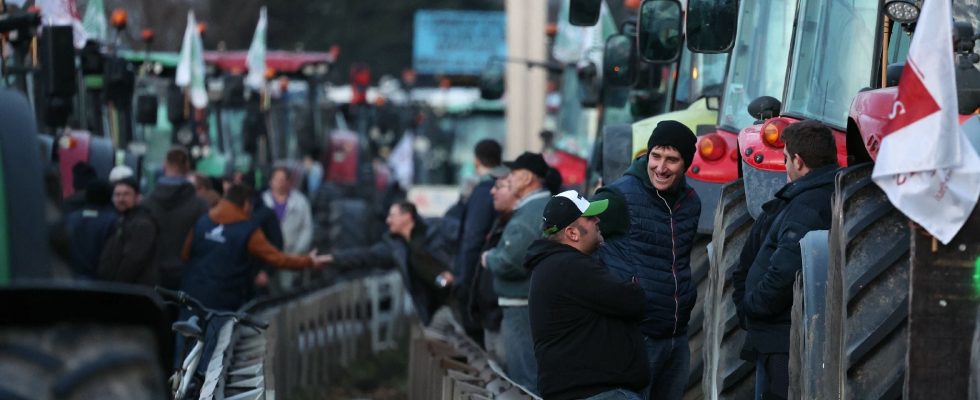Road blockages extending from Pau to Bordeaux, reaching Brittany and Picardy, spread to the south-east of France. Started at the start of the week in Occitanie, the revolt of European farmers is gaining momentum on French territory. On Wednesday January 24, the Peasant Confederation, the third agricultural union in the country, classified on the left, called on all of its members “to mobilize” with farmers already on the ground, joining the Rural Coordination and the National Federation of Farmers’ Unions. farmers (FNSEA).
Among the reasons for this crisis with multiple implications is the CAP, for Common Agricultural Policy, the European plan to support agriculture. Three letters which concentrate the sector’s grievances against the European Union. “The movement will become widespread, it started in Germany, it is in Romania, it is in Holland, it is everywhere, it is generalized fed up, it is the failure of the CAP,” declared at the start of the week Serge Bousquet-Cassagne, the very influential president of the Chamber of Agriculture of Lot-et-Garonne.
A bureaucratic mountain
Representing almost 30% of the European Union budget, the CAP has in recent decades become a veritable machine for subsidizing agriculture. And France is the first beneficiary, with 9 billion euros in aid per year. This system creates, in fact, a multitude of standards for French operators. Everyone agrees that the regulatory mille-feuille which now governs the work of farmers, ranging from the use of phytosanitary products to the size of cages for poultry, has become too burdensome. “When we talk about complexity, it is in reality a multitude of rules that come from all corners, and the latest regulations have added even more,” says Luc Vernet, co-founder of the European think-tank Farm Europe.
Since the reform of the CAP in 2023, the distribution of aid has been less vertical. For the first time, European agricultural policy is implemented in each State via national strategic plans. This method aims to respond to a recurring criticism which makes Brussels a factory of constraints imposing its views on the agricultural world. However, the translation of this CAP at national level brings an additional layer of bureaucracy.
“It must be recognized that the French national plan is absolutely complex, with justifications to be provided for everything,” notes Jean-Christophe Bureau, professor of economics at AgroParisTech, referring to the 1,200 pages of the text. This administrative burden has a cost, underline the experts. It can also be a source of stress for a certain number of professionals, who fear making a mistake that could suspend these subsidies. “There is real concern about not being on track, when all of the direct aid these farmers receive sometimes forms the entirety of their income,” points out Luc Vernet.
Environmental standards in shambles
Regulations on pesticides, preservation of biodiversity… There are many texts that farmers oppose. But it is above all the European “Farm to Fork” strategy which is fueling anger. This transition plan for European agriculture is one part of the European “Green Deal”. In particular, it plans to increase the share of organic farming to 25% by 2030, or to reduce pesticides consumed in the EU by 50% by this deadline. However, despite the fears of farmers, these measures, which still arouse broad opposition in the European Parliament, have not come into force. And their future is today compromised by political blockages within institutions. “Despite everything we hear, these regulations do not yet exist, and probably will not exist when we see the backpedaling of the President of the European Commission on the subject,” tempers Jean-Christophe Bureau.
If this aspect of the green pact remains unresolved, farmers are not exempt from environmental standards. Introduced in 2003, the principle of conditionality of aid was reinforced during the programming of the CAP in 2023. It requires compliance with several requirements, in particular good agricultural and environmental conditions (GAEC). These relatively flexible criteria provide for crop rotation, the protection of wetlands, or even the obligation to maintain certain meadows. Since the 2023 reform, to receive more aid, farmers can adhere to more environmentally demanding processes, called eco-schemes. An additional level of justification which should make it possible to initiate a transition towards more virtuous agriculture, but which arouses opposition in a sector very dependent on subsidies. “For a long time, we gave money from the CAP without compensation, or very little. Now, we are trying to impose it, so obviously it is blocking…”, notes Jean-Christophe Bureau.
The sting of the green deal
Recent developments in the CAP nevertheless seem to lag behind the necessary transition of the agricultural model. In 2021, a report submitted to the Commission by a team of scientists from the National Institute of Agricultural Research (INRAE) and AgroParisTech highlighted the gap that still existed between European ambitions and the reality of the Common Agricultural Policy: ” The European Union’s agricultural and food practices fall far short of meeting the ambition, purpose and quantitative targets of the European Green Deal with regard to climate, environment, nutrition and health in this sector,” they wrote. Since then, the new version of this policy does not seem to have moved the lines. “What is impacting this crisis is what is displayed in the Green Deal for agriculture and opposite, a CAP which has not yet made its Copernican revolution and which is not yet up to the task of the support necessary for this transition”, comments Cécile Détang-Dessendre, INRAE research director. A new version of the CAP is expected for 2028.
